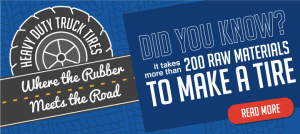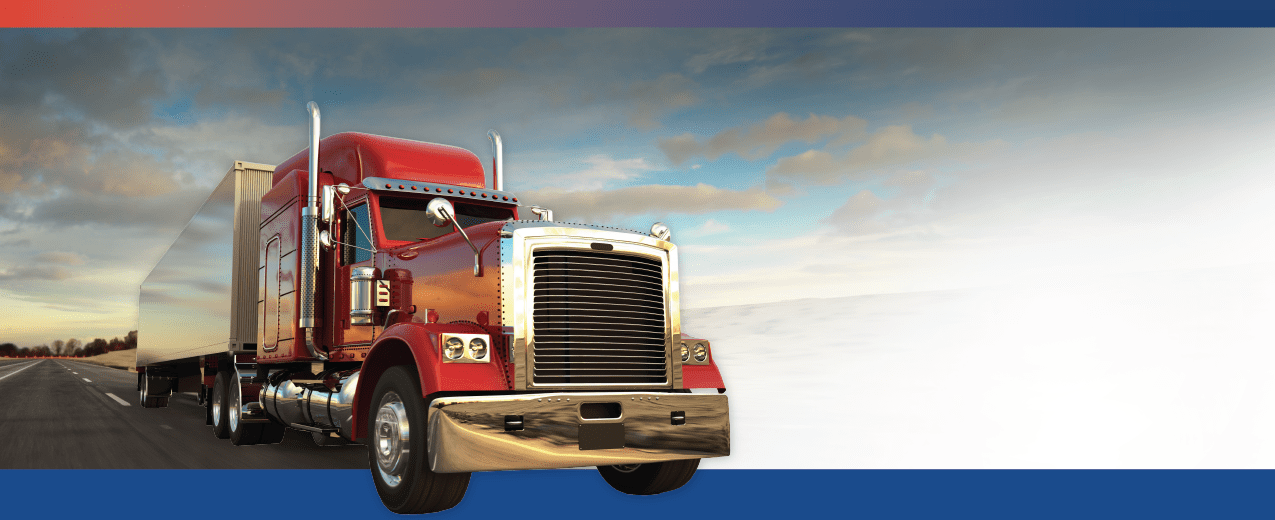
Heavy duty truck tire information
Tires are critical vehicle components because they connect trucks and trailers to the road and allow drivers to steer safely on diverse terrains. Since they play such an important role in vehicle operation, it can be beneficial for drivers to understand how to prevent wear and tear. Learn more about tire components and get helpful maintenance tips.
Facts about commercial tires
There’s a lot more to tires than you might think. For example, did you know one tire is composed of more than 200 raw materials? Or that motor carriers (MC) and drivers can receive poor Compliance, Safety, Accountability (CSA) scores because of damaged tires? Check out the infographic below to learn more.

Parts of a tire
Standard radial tires consist of seven main layers. Each part works differently to enhance flexibility, durability, safety and fuel efficiency. The information below outlines where each layer is located and its purpose:
1. Inner liner
This makes up the innermost part of the tire and is composed of synthetic rubber. Its function is to hold high-pressure air inside so it can’t seep through the rubber structure.
2. Carcass ply
The carcass ply is directly above the inner liner and consists of textile fiber cords bonded into the rubber. This layer strengthens the tire, helps it resist pressure and determines the loading capacity.
3. Bead
The bead is the underlining edge of the tire that secures it to the rim. It’s composed of bead wire, steel and rubber, and works to keep the tire and rim fastened together in the event of sudden air pressure reduction.
4. Sidewall
The sidewall is located between the tread and the bead and has several functions. It keeps the carcass ply from receiving damage, protects the tire from rough impacts while driving and gives it flexibility.
5. Belts
The belt, also called the crown ply, is made of resistant steel cords bonded into the rubber. It’s located between the tread and carcass, and acts as a reinforcing layer to keep those parts connected.
6. Cap ply
This layer is directly underneath the tread and is made of polyester fabric that helps hold everything in place. Its function is to prevent the tires from overheating due to friction, and help them keep their shape at high speeds.
7. Tread
The tread is the outermost layer and contains a blend of natural and synthetic rubbers that help the tires resist heat. Because it makes direct contact with the road, it has the thickest rubber.
What the sidewall information means
Information such as the Tire Identification Number (TIN), ply material, and Tire Performance Criteria Specification (TPC Spec) are labeled on the sidewall. You can also find the tire size — a combination of numbers and letters that describe the:
- Section width. A three-digit number that measures (in millimeters) the tire’s outermost most edge to its innermost edge.
- Sidewall aspect ratio. This indicates the sidewall’s height from rim to tread as a percentage of the section width. For example, if the number is 70, that means the height is 70 percent of the tire’s width. The bigger the number, the taller the sidewall. The smaller the number, the shorter the sidewall.
- Type of construction. There are two types of tire construction — radial and bias-ply. An uppercase R indicates radial tires. A tire labeled with an uppercase B or D represents bias-ply tires.
- Rim diameter. The number indicating the size (in inches) of the wheel that fits the tire.
- Service Description. The service description includes the load index and speed rating. The load index specifies the maximum carrying capacity of the tire. The speed rating indicates the top speed a properly installed tire can reach.
Tire maintenance and safety tips
Driving on worn-out or damaged tires is dangerous and is against Federal Motor Carrier Safety Administration (FMCSA) rules. If a truck driver is caught driving on unsafe tires, the FMCSA will assign points that can majorly impact a carrier’s CSA score. Avoid violations and poor CSA scores by following these tips to keep your tires in good shape:
- Perform a pre-trip inspection
- Inflate to recommended PSI
- Wash the tires and wheels
- Get tires rotated regularly
- Practice good driving habits
FleetNet America® tire services
Need help maintaining your tires? FleetNet America offers a preventive maintenance (PM) program and tire repair services to cover all your needs. For more information, call 877-559-9640.
